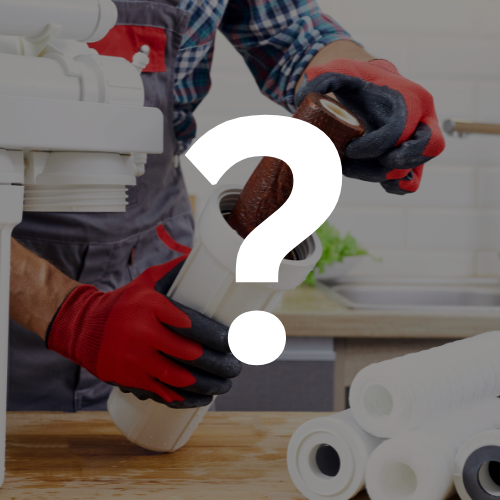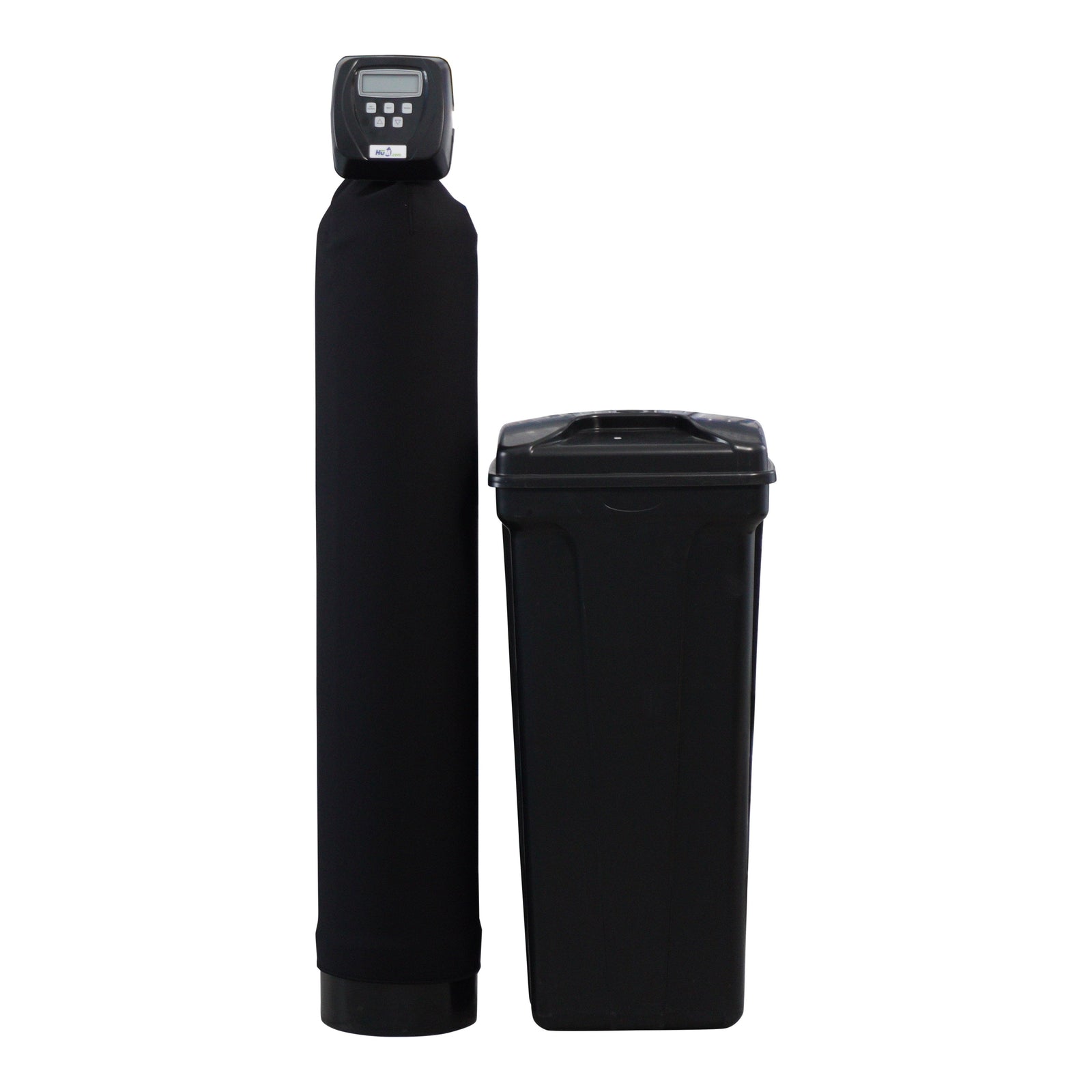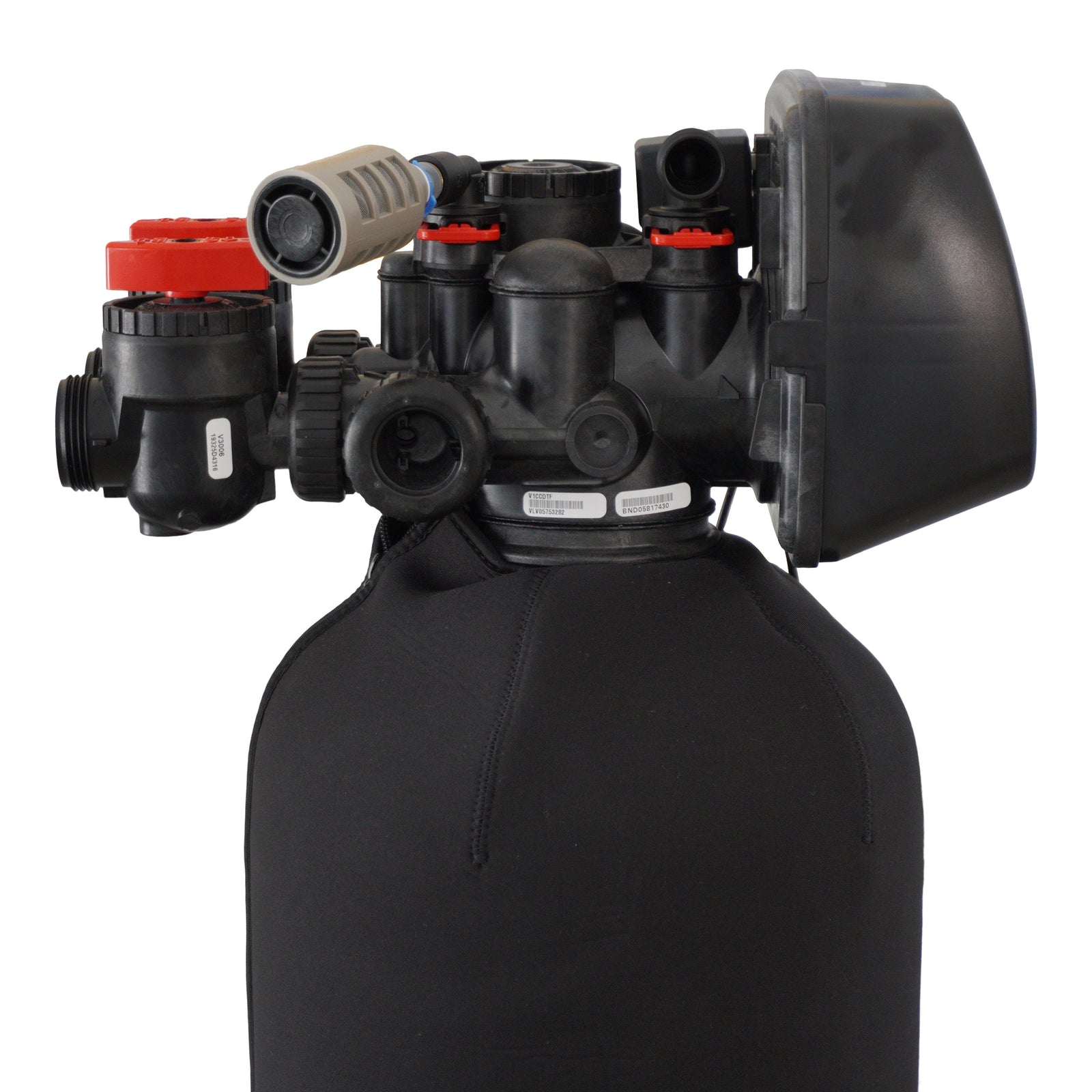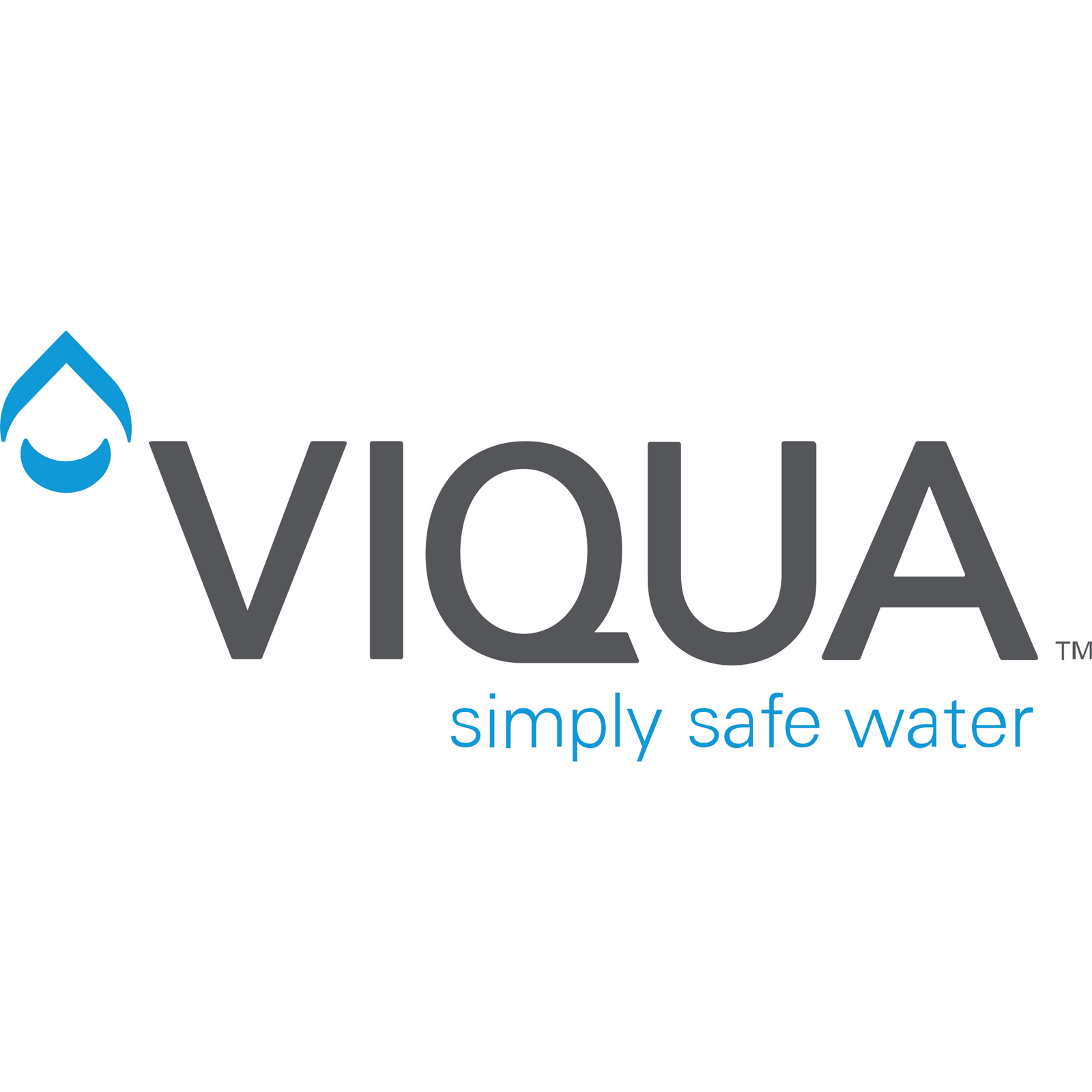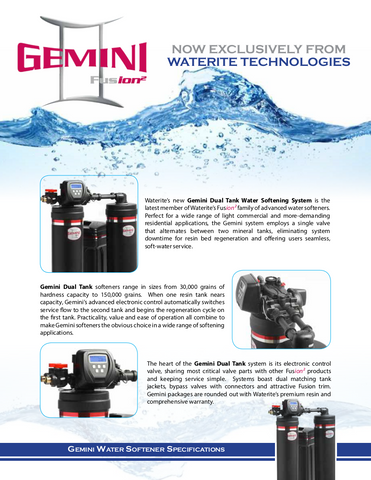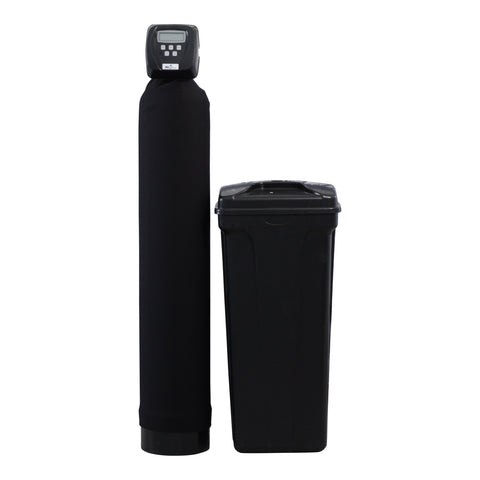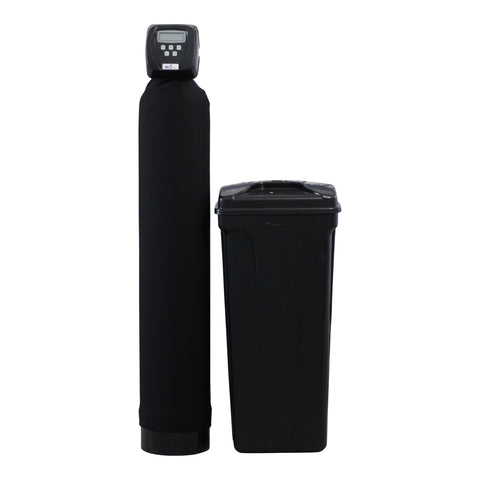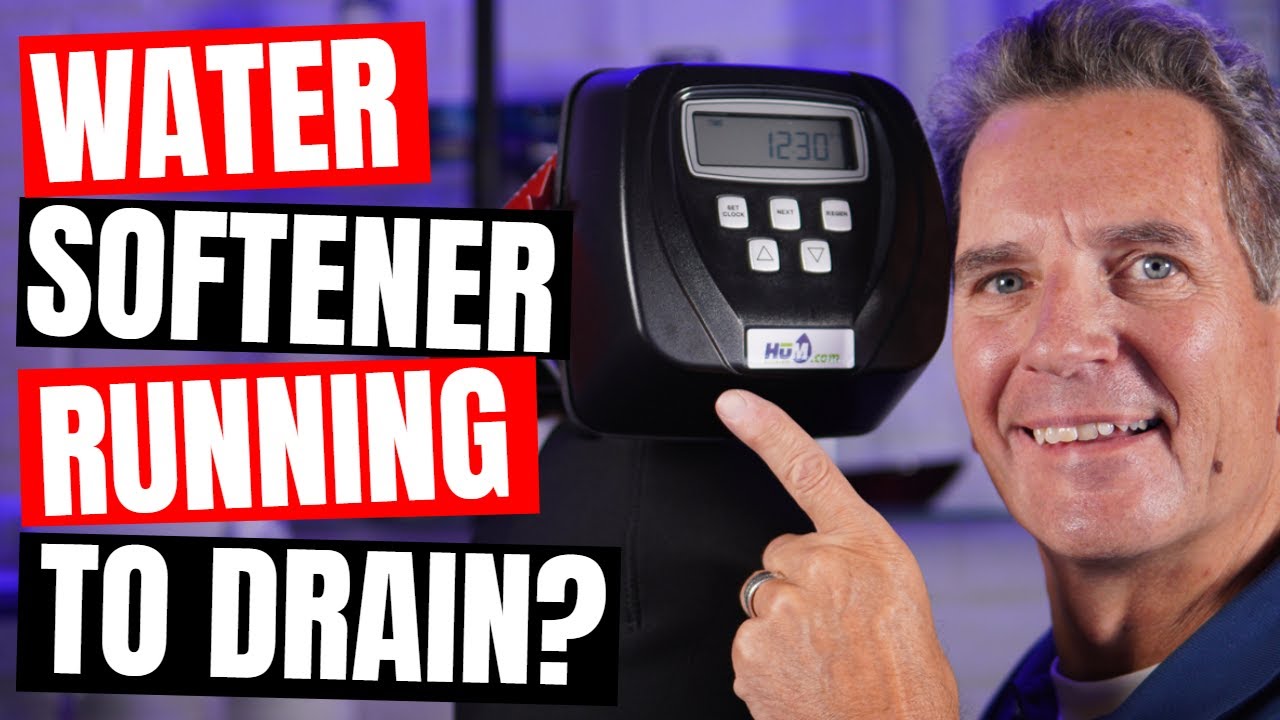
The quickest way to confirm that the fast flowing water you hear is being caused by your water filtration equipment — and to stop the flow — is to bypass it. If the flowing stops, you're right, that water softener is the culprit!
The next step would be to check to see if the valve is in service or in a regeneration (REGEN) cycle. In service, there should be NO water flowing to the drain, while during regeneration there definitely SHOULD be water flowing to the drain and there would be no concern.
THE PROBLEM: FAST FLOW WATER
If it's not in REGEN mode, then water constantly flowing to the drain from your water softener can either be flowing slowly, which you can just barely hear, or flowing so quickly that the water is gushing through the drain line to the drain. If it’s flowing quickly, you can simply grab the drain line and if you feel vibration from the line, then you’ve just confirmed it.
THE PROBLEM: SLOW FLOW WATER

If the water is flowing slowly, you can confirm that source by a number of ways. If the water softener drain line is sitting in a drain stack, you can simply pull it out to check.
If the drain line is attached at both ends, however, it becomes a little more difficult. You'll first need to make sure the water softener is in service and not in the middle of a regeneration cycle. You can determine that by looking at the valve and making sure that if it is an electronic valve it is not counting down a cycle. If it’s a mechanical valve make sure the “window” is displaying “Service”.
Then put the water softener in bypass and disconnect the drain line, being careful to catch any water coming from the drain line in a bucket — especially if it discharges up.
Once disconnected, slowly open the bypass valve; if you have a leak to drain, water will slowly or quickly flow from the drain port on the valve. Once confirmed, re-attach the drain line.
Whether the flow to the drain line is caused by the valve being stuck or water leaking past the piston seals, the solution is one of two things.
- The motor has stopped working and cannot advance the valve through the cycles.
- The seals need to be replaced because they have become compromised and are holding the piston in place against it’s will, or they have become compromised and water is leaking past the pistons.
THE SOLUTION

If you have an Aquamaster or WaterBoss water softener, the solution is to replace the drive end cap assembly. I’ve got a great video that shows you how here!
For a Clack WS1 Water filtration valve, here are the steps to solve the problem:
- Start a regeneration (REGEN) and bypass the water softener.
- Once it's slowed down, pull out the e-clip, disconnect the drain line and catch any water in a bucket that might be in the drain line.
- Remove the faceplate and unplug the power.
- Unplug the electrical connections, tuck aside, and remove the Drive Bracket.
- Unscrew the Drive Cap Assembly, having a bucket available in case water leaks out. Then pull out the piston and regenerant piston, if there is one.
- Remove the Spacer stack assembly.
- Replace the Spacer stack and piston(s), reassemble in the reverse order and then tighten.
Once everything is replaced and put back into service, the trickling and water flowing to the drain issue should be gone!
For my next video on water filtration equipment troubleshooting and repair, click here and I’ll see you there!
Video Transcript
Gary The Water Guy:
Do you have water constantly flowing to the drain from your water softener, iron filter, tannin filter, any water filtration equipment with a valve on it? In this video, I'm going to show you how to troubleshoot it. And I'm going to show you how to fix it starting right now.
Gary The Water Guy:
Hi, I'm Gary The Water Guy and I simplify water filtration to help you conquer crappy water for your family. The simplest way to confirm that the cause of the water flowing or trickling through your plumbing at the moment that it's your water filtration equipment is to bypass it. So you just go to the bypass, flip it onto bypass. Once it's bypassed if the trickling or the flow goes away that means it's definitely this piece of equipment that's causing the problem.
Gary The Water Guy:
Okay. So with it being in regular service, now you need to check and see is it in a regeneration cycle? Because if it's in a regeneration cycle, that's a hundred percent normal for it to be doing that. And most electronic water softeners they display the current time, or they display flow rate or something like that, but they're not counting down. If it's counting down, that means it's in a regeneration cycle. You can fast forward by pushing the regen button to get to the end, and then make sure that the water flowing has stopped. If however, it is in the service cycle and you hear water flowing, then there's a problem inside the valve.
Gary The Water Guy:
If the water is flowing quickly, you can hear it or you can actually feel it because the drain line that goes through here, you can grab it and you can feel the vibration as the water is flowing through. But if it's just trickling slowly, you may not be able to tell that it's actually coming from here. So the best way to confirm that is again bypass it. Once it's bypassed, then what you can do is you can disconnect the drain line. Now, if your drain line flows up, then you're going to have to have a bucket or something nearby because there is going to be some water coming down from it. So you just undo this e-clip in this Clack WS1, remove it, and then catch any water that's here. Once you've removed it again, making sure that the water softener or water filtration equipment is in service.
Gary The Water Guy:
Then what you need to do is slowly open up the bypass. Okay? And if you see water flowing out through where the drain line is normally connected, that tells you that there's an internal leak in the water filtration equipment, and that's what needs to be addressed next.
Gary The Water Guy:
So the problem is inside the valve. So either the motor is stuck and it's stuck in one position, or the piston is stuck and it can't move back and forth. If you suspect it's the motor, then what you can do is you can press the regen cycle or the sorry, the regen button to advance it to another cycle. If you hear the motor startup then it's not the motor that's causing the problem. It's the piston and or the seal pack.
Gary The Water Guy:
If you have an older style mechanical type water softener like a Fleck 5600, like this one here, then you can check the cycles by just... So it's in service when you see this little window up here and you see the word service displayed in the window. So you can turn this like this to put it through the cycles. Now, if you check it and water is continuously flowing to drain and it's stuck up here, it won't move past there. You try to turn it, it won't move. That means it seized up inside and you need to replace the seal pack and the piston.
Gary The Water Guy:
Now for a WaterBoss or AquaMaster water softener, the next step would be to replace the drive end cap assembly. This unit here it's the piston. So what's happened is the piston is probably stuck in there somewhere, or there's a problem in the drive.
Gary The Water Guy:
For a Clack water softener same story is the seal pack needs to be replaced and the pistons. Now with the Clack WS1 water softener if it's a water softener it'll have these two pistons. If it's a backup washable filter, like a sediment filter or something like that, it'll just have this one. But once you open it up you'll see better. It's just that if you're ordering replacement parts, you need to order them ahead of time to make sure all set. So again, if it's a water softener you've got two pistons. If it's a back washable sediment filter or backwashable carbon filter you just have the one.
Gary The Water Guy:
All right. So to replace the seal pack and the pistons in the Clack WS1 we'll remove the face plate. And so normally this would be in service. If it's not, you would put it in bypass like it is here now. Once you've done that, you need to release the pressure inside. So you can start a regeneration cycle by holding down the regen button for five seconds. That'll start a cycle. You hear the motor start up. That's the cycle. And once it starts counting down you know that it's started the cycle. So once it has started counting down, you'll hear a whoosh of water and then it'll slow right down. Once it's slowed down, then you can disconnect the drain line. So again, if your drain line goes up there's going to be water in that drain line. So make sure you've got a container ready so you can capture that water. So you just pull out the e-clip, disconnect the drain line, and drain it down. You can set it aside.
Gary The Water Guy:
So there's a couple of connections across the front. You just have to undo the electrical connection here. Also good idea to unplug it from the wall just in case any water gets inside here. And then you just unthread the electrical line here. You can just tuck it in behind if you like, like that. And then you can undo this whole assembly at the front. It comes out as a unit. So there's these two clips here. You can just undo those, pull it forward like that. As you can see this whole unit comes out as a unit. You can just set that aside carefully. You don't want to step on it or something like that. And then what you need to do is you need to disassemble it inside. So the disassembly tool for the Clack WS1 is a good tool to use for that.
Gary The Water Guy:
Put it in there to loosen it up. Now you can use a screwdriver in here, a flat-bladed screwdriver and kind of walk it through it. It does work. It's very cumbersome. Like I say, this tool does make it a lot easier. So then you unscrew this assembly here, and this is the drive assembly. So I would have a container underneath here to capture any water that flows out when you open this up. So this particular valve here is what I call Frankenstein. This has been built up from a number of leftover parts, et cetera. I typically use this for situations like this, and also for trade shows and et cetera. So then what you can do is you can just pull out the assembly. So that's what I was talking about earlier is a here's the piston and then here's the brine piston. So for an iron sulfur filter that has a regeneration cycle where it sucks in the air as opposed to a water softener which sucks in the brine, they have this little piston here. Okay?
Gary The Water Guy:
And then what you need to do, you need to remove the seal pack, which is inside here. So you can grab that and pull it out. And as you can see, this is quite used. It's quite dirty, so you can clean this at this point, but if it's leaking past the seals and that's what's happening, that's why water is running to drain, it's leaking past the seals inside here. So you're just going to throw this away anyway. And then you would replace it with a new seal pack, which just slides right in like so. And then you've got the new, so you can just unclip the piston. It just clips right in. There's a little groove in there where it clips in. Just unclip that.
Gary The Water Guy:
So then here's the new piston and the new brine piston. So you just clip the two together. It can only be clipped in one way, so you don't have to worry about putting it in the right way. And then you just clip it into the drive assembly like that. Clip that in. And then you can use some plumbers clear silicone grease on the seal that's inside here. You don't use it on any of the seals inside the seal pack, but you can put a little bit on here on the o-ring that's on here. Thread that in. And you're just going to reassemble this. Now it needs to be tight, but you don't have to reef it on there really hard. But again, you can use the assembly tool to tighten it up. All right. And then just be careful of the power wire that's up here. Just make sure it's clipped all the way in at the top here.
Gary The Water Guy:
Once you've done that, the feet go in the bottom, clips on the bottom, both sides. Bring that back and that'll snap into place. Make sure it does snap into place that way you know that it's seated correctly. And so then you can attach the power right there and it will go through the setup procedure. It takes a few seconds to go that, and then it'll be done when it goes back to the correct time, and you don't hear the motor making noise anymore. And then you would reconnect the drain line. Make sure it's tight. Put it back into service. The trickling and the water flowing to the drain will be gone and you're done.
Gary The Water Guy:
For some more great troubleshooting videos on your water filtration equipment, click up here and I'll see you there.

